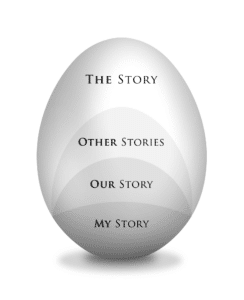Seventh Sunday in Ordinary Time, February 23, 2025
(click here to listen to or read today’s scriptures)
Cosmic egg
Nineteenth century philosopher and theologian Soren Kierkegaard invented existentialism. He also suggested an egg to describe the way we grow through (his terms) the aesthetic (desire for everything), the ethical (duty) to the religious (taking my “leap of faith” into my spiritual self). As I move through these forms I become more aware of my own sin and the rights of others besides myself. The first two stages are not wrong, but they are eventually insufficient for living a moral life.
Richard Rohr uses the “cosmic egg,” which is present in many mythological traditions, to describe this movement. I found this description in a fascinating blog:
Richard Rohr’s interpretation is of three eggs one inside the other, like Russian Matryoshka dolls. In his theory, the smallest egg, “My Story”, is a me centered, ego-driven narrative, which revolves around my status, my things, my Instagram followers, etc. you get the idea. The next bigger egg is “Our Story” which revolves around group mentality: my country, my religion, my football team, my race. Definitely, “Our Story” is a step up from “My Story”, but there are bigger and better things out there: “The Story” is the universal story that connects all of us, it is the transcendental stage where everything makes sense, it is the place of love, forgiveness. wisdom, listening, and understanding. It is what is.

As you can see from the picture, Fr. Richard has added a fourth level of eggness, “Other Stories.”
The term “other stories” illustrates the significant but sometimes painful recognition that our story is not the only frame, not likely the most important frame, and maybe even a frame with a lot of shadow and bias. This is the great advantage of studying history, literature beyond our own language, anthropology, world cultures and religions, and experiencing some world travel, whether by opportunity or necessity. This is also the invitation modeled by Jesus to move beyond my story and our story, and to stand in friendship and solidarity with other stories.
As we encounter more and more of the world’s other stories, many people are broadening their wisdom, while others are broadening their fear. There is only one thing more dangerous than the individual ego or my story, and that’s the group ego that insists that our story is the measure of all things and so seeks to label other stories as ignorant, dangerous, or inferior.
Kierkegaard required a “leap of faith” to move into the top level of egg, what he termed the “ethical-religious.” For Rohr, biblical revelation allows us to see ourselves clearly and move forward:
Biblical revelation is saying that the only way we dare move up to the story and understand it with any depth is by moving through and taking responsibility for our personal story, our group story, and other stories. We have to listen to our own experience, to our own failures, to our own sin, to our own salvation, and we’ve got to recognize that we are a part of history, of a culture, of a religious group, for good and for bad. We cannot heal or honestly examine what we do not acknowledge.
In Rohr’s CAC’s weekly summary of these ideas, Richard continues:
True transcendence frees us from the tyranny of I am, the idolatry of we are, and the scapegoating of they are. When all four stories are taken seriously, as the Bible shows us very well, we have a full life—fully human and fully divine.
In one of his more mystical moments, Paul wrote to the Corinthians of just such a movement:
Brothers and sisters:
It is written, The first man, Adam, became a living being,
the last Adam a life-giving spirit.
But the spiritual was not first;
rather the natural and then the spiritual.
The first man was from the earth, earthly;
the second man, from heaven.
As was the earthly one, so also are the earthly,
and as is the heavenly one, so also are the heavenly.
Just as we have borne the image of the earthly one,
we shall also bear the image of the heavenly one.
And David, warrior in the wilderness running from Saul, saw the king through a lens focused by God’s big picture when he and his friend Abishai had a chance to kill him:
Let me nail him to the ground with one thrust of the spear;
I will not need a second thrust!
But David said to Abishai, “Do not harm him,
for who can lay hands on the LORD’s anointed and remain unpunished?”
Not the second thrust, but a second look. I turn away from what I see at first, out of my own fear and need to be right, and then God’s view becomes more clear.
(1 Samuel 26, Psalm 103, 1 Corinthians 15, John 13, Luke 6)
(posted at www.davesandel.net)
#